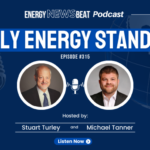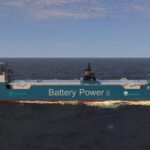Energy News Beat
Daily Standup Top Stories
Even the World’s Biggest Electric-Vehicle Market Is Slowing
HONG KONG—Chinese electric-vehicle makers that enjoyed years of explosive growth now face a slowdown in domestic demand, spurring them to push overseas and challenge global auto giants already struggling with a transition to battery-powered cars. A subsidies-driven […]
Government Approves Construction Permit for New Type of Nuclear Reactor for First Time in Decades
For the first time in 50 years, the U.S. Nuclear Regulatory Commission has issued a construction permit for a new type of nuclear test reactor. The Hermes demonstration reactor will be built in Oak Ridge, Tennessee, by California-based […]
Shocking development: Biden plans to roll back rule designed to juice EV push on country
The Biden administration is planning to slow down the rollout of a rule that was designed to juice the United States’s transition to electric vehicles. The administration is reportedly planning to relax its limits on tailpipe emissions, in an election-year […]
Why Toyota May Have the Best Strategy in the EV Race
Toyota’s hybrid vehicles and investment in solid-state batteries pose a significant challenge to Tesla’s market dominance in electric vehicles. Despite Tesla’s high valuation and innovation, Toyota’s cheaper stock price and potential in hybrid and solid-state […]
Two Wind Farms Received Over $100 Million To Switch Off
Regular readers will know that I have long been concerned over the extraordinary level of payments to wind farms to switch off. These so-called ‘constraint payments’ are deemed necessary when the wires in the transmission […]
Why California’s climate disclosure law should doom green energy
California prides itself for being a leader with respect to tackling climate change. This is because they believe, albeit on shaky scientific grounds, that their citizens “already” face devastating consequences inflicted on them by manmade […]
Highlights of the Podcast
00:00 – Intro
01:04 – Even the World’s Biggest Electric-Vehicle Market Is Slowing
05:46 – Government Approves Construction Permit for New Type of Nuclear Reactor for First Time in Decades
07:34 – Shocking development: Biden plans to roll back rule designed to juice EV push on country
10:04 – Why Toyota May Have the Best Strategy in the EV Race
15:20 – Two Wind Farms Received Over $100 Million To Switch Off
17:46 – Why California’s climate disclosure law should doom green energy
22:38 – Outro
Follow Stuart On LinkedIn and Twitter
Follow Michael On LinkedIn and Twitter
– Get in Contact With The Show –
Video Transcription edited for grammar. We disavow any errors unless they make us look better or smarter.
Stuart Turley: [00:00:14] Hello, everybody. Welcome to the Energy News Beat podcast. My name Stu Turley, president CEO of the sandstone Group. Today is Saturday the 24th. February 24th. Already we had a crazy wild week in the news. And I mean, it is crazy. There are some things going on though. I got to give a shout out to, Andrew Corbett, you and he had put out on his Substack CNN attempt to smear India for purchasing Russian oil fell flat. In the words of Serena’s love, sanctions don’t always work as intended. This was a pretty good article on energy news. Meet not go. Have a great day. Have a great Saturday, hug your family, hug your dog, and pass the word along. Thanks, Michael, and I’ll see you next week. [00:01:03][49.2]
Stuart Turley: [00:01:04] All right. Hey, let’s get rolling around the country here. Excuse me? The world, even the world’s biggest electric vehicle market is slowing. Boy. Michael, you take a look at that big picture. Well, that’s a lot of EVs on racks, man. That looks like, Hot Wheels just all lined up. The explosion growth. Michael is just nuts on what they were trying to do to the rest of the world, as they were just building the cheap EV cars. And now they’re, just proliferating around the world, and they’re piling up everywhere. This is an interesting point. B why did the crown jewel, the, the Chinese carmakers is backed by Warren Buffett? Interest added in a factory capacity alone by December to churn out 4 million cars a year. But California can’t put any, charging stations in. So I find this quite humorous. That figure is a million more than it’s sold in 2023. That is not that goes along with our next story coming around the corner. It’s foreign, factory making EVs, delivering cars from Uzbekistan. And a second in Thailand starts in July. Brazil and Hungary in the coming years are setting up a plant in Mexico which would consider exporting to the U.S. that sells for $11,000 in China. Is that a scooter? Is that you know, for I don’t know, man, is that Holy smokes. [00:02:42][97.4]
Michael Tanner: [00:02:43] Well, I think the first thing that that’s interesting is that there’s a, you know, there’s a map. You know, there was this boom of buying electric vehicles around the world. I mean, there’s a reason guys like Warren Buffett got in on it. You know, the last I would say, outside of 2023, 2018 to 2022, there was quote unquote, this explosive growth in EVs. But now that growth has slowed. And as Stu mentioned, you’re you’re cranking out 4 million cars a year when you’re only selling 3 million. That’s where it’s going to get you. You know, Miss Producer, you can throw up this the the head image. That’s where you get the Hot Wheels. You know, you can just pick em out right there and just start running them down the tracks. Point is, this is now going to only make EVs cheaper. And if they plan on moving and trying to take market share in the United States, it’ll be interesting to see if that happens, because I’m not convinced. I mean, I’m with you. I wouldn’t want to get in an $11,000 car. That’s really a scooter. I mean, it’s like every European movie. You see, when the bad guys run and buy any slams into one of those, like, smart bikes, all I can think about is now I’m just, oh, no, I’m going to end up on, get my car stolen as an extra in an action movie. But what this will do is, is only make it cheaper. And I wonder what this will do to Tesla’s dominance in the United States. You know, another interesting point of this article is they point out that Tesla is not the major EV provider worldwide. They’re only the major EB provider in the United States. And what happens when these these cars will inevitably make themselves make it into America? It’s just going to happen. Like Hyundai, like Toyota, it eventually things just migrate into the United States, from overseas in terms of top brands. So it’ll be interesting to see how consumers differentiate. I mean, I think, oh yeah, Tesla has going forward is the autopilot in the self-driving. And you could argue that that is the reason Tesla is more valuable than the fact that it’s an EV. It’s that they know it’s at least theoretically revolutionary technology that could allow us to basically all stop driving. [00:04:41][117.9]
Stuart Turley: [00:04:41] Which would be, I’ll tell you, I don’t know enough about this one yet. But, Michael, the insurance around the world for EVs is doubling and tripling. And so I think you’re going to see a slowdown in EV purchases because of insurance. And, quite honestly, when you have an EV break, all you have to do is crack one small, battery panel and then in the EVs total. Yeah. So. You know, I don’t know. [00:05:11][30.0]
Michael Tanner: [00:05:12] I don’t know. I don’t know if I want to own. I’m not owning an EV. I think and I think what this article points out specifically is that there’s a there’s kind of an inflection point coming with EVs where the supply is outpacing demand. And that as an economist, that always leads to a massive price drop. So maybe this will allow more people who want an EV to get it. The question is where do those price cuts come into? Is it. [00:05:36][24.2]
Stuart Turley: [00:05:37] Testing. Yeah. [00:05:37][0.5]
Michael Tanner: [00:05:38] Prices or is it China? And is BYD pushing really hard to get its cars into the United States because they have the price advantage? [00:05:46][8.2]
Stuart Turley: [00:05:46] Government approves construction permit for a new type of nuclear reactor. First time in decades. This is huge. The U.S. Nuclear Regulatory Commission has issued a construction permit for a new type of nuclear test reactor in Oak Ridge, Tennessee. Molten fluoride salt instead of water is a coolant. This is really huge. Kairos power is, thrilled to have, its archive and its major regulatory milestone. As for some final preparations to start construction at the Hermes site next year, said Mark LaFleur, Kairos Power chief executive, I’m going to reach out to him and see if I can get him on fact, I already have. I’ll have to reach out again to. That’s pretty darn cool. [00:06:32][45.9]
Michael Tanner: [00:06:33] Yeah, it’s it’s going to be very interesting. And they specifically mentioned, our favorite Miss America. Gray. Stanky. [00:06:39][5.8]
Stuart Turley: [00:06:39] Oh, yeah. She’s got the article. [00:06:41][1.4]
Michael Tanner: [00:06:42] We got to give a look. We’ve had her on the podcast multiple times. I mean, this is good, you know, because talking about the cheapest and most efficient form of energy that really is nuclear. You know, guys like Doug Sandridge have accurately laid out why, if we could do this properly, nuclear is the best move. The problem is you’ve got these regulatory commissions, you know, legislation through regulation. It’s making it’s becoming it’s so hard to permit these that we we get all excited when just a new construction permit is there. It’s a test reactor. As much as I’d love to jump up and down. What’s that going to? It’s a test reactor. [00:07:21][38.6]
Stuart Turley: [00:07:21] You’re still 5 to 10 years away. [00:07:23][1.4]
Michael Tanner: [00:07:23] And then you got to get another permit to build the actual one, right? So we need to. You know, once I hear about nuclear regulation reform, then I’ll get excited. [00:07:34][10.0]
Stuart Turley: [00:07:35] Hey, let’s start around here with our buddy Biden. A shocking development Biden plans to roll out back rule designed to juice EV push on the country. In our picture of I’m going to just leave that alone. But he’s hanging out of his head and he can’t even drive. The Biden administration is planning to slow down the rollout of a rule that was designed to juice the United States transition to electric vehicles. Michael, this is, very much do you remember, the prime minister of the UK took a beating because he did the same thing. The EPA just rolled this out. The new car rule last year would require nearly 70% of new car and truck sales to have no tailpipe emissions by 30. 2032. The critics claim the sudden shift would devastated the US auto industry, so they’re going to give them a reprieve by a couple of years. Michael and I think that this is going to be a little bit of a black guy. We know they’re, pandering to the climate activists, and this is going to be a big problem. They can say, oh, we’re not quitting, but we are pushing it out because of the EV failure. [00:08:57][82.6]
Michael Tanner: [00:08:58] Yeah. Well, it’s it’s funny how they wait a year too long to roll out with stuff. It’s it’s sometimes like a little too little too late, unfortunately, because you’ve still got California going full steam ahead with their with their plans, which yes, as on a countrywide it doesn’t matter. But you still have the individual states which we’re all in favor of state power here. [00:09:23][24.9]
Stuart Turley: [00:09:23] He there are 17 states that have added legislation, Michael, that says anything California does they can be is stupid. So so goes California. So goes 17 stupid states. [00:09:36][12.9]
Michael Tanner: [00:09:37] So this is this is but you have to remember this was just a leak of a potential announce. They haven’t said anything yet. [00:09:42][5.6]
Stuart Turley: [00:09:43] Oh there they this was a flag to throw out there to see how bad it got. And I guarantee you they’re going to have to because the unions, the one union boss that is out there is costing a lot of jobs out there, and he’s got to do something to appease them and realize that. Let’s go to Toyota. Michael, I’m going to brag on me and you here for half a second. Why? Toyota may. Had the best strategy in the EV race. You and I have been on this for quite a while and that is why are we not putting EVs? I mean, secondary and I again, I love Elon, I love Woody Allen’s doing. And why don’t we just go to the Toyota hybrid model? Let’s go through some of the numbers in here. The four quarters Tesla has generated total revenue and earnings of 96,000,000,015 billion, for, respectively, for Toyota. Toyota’s revenue roughly three times larger. Oh, excuse me, at 299 billion, in 44 billion, profits. But yet Tesla’s market cap is more than double that of Toyota. And that’s because of the carbon credits and and everything else in there. [00:11:04][81.8]
Michael Tanner: [00:11:06] So it’s it’s extremely fascinating why Tesla trades at such a multiple relative to the other carmakers. You know one would say I would say it’s a lot to do with they were a tech company masquerading as a you know they’re they they’re trying to brand themselves as a tech company when they’re really a car company. The problem is they really are a tech company with autopilot. And a lot of the stuff they’re doing on the software space. I don’t have a problem with valuing Tesla higher than I do other automakers, because if they figure out autopilot and are able to license that software to other companies, they will far and away become larger than the physical automakers. Now they also come out with really cool cars. It is interesting the model, and this is where comparing comps becomes a tricky issue. We saw this in in you, in in a soon to be released deal spotlight with John Farrell. We, we we highlighted the difference of the multiples between pioneer what pioneer guy and, being bought by Exxon and what Diamondback paid for endeavor. But it’s hard to compare them because there’s so much extraneous stuff around it that multiples don’t necessarily make sense. Being able to pick comparable companies to say this is a comparable transaction. Therefore, this is how much I should be valued. He’s tricky. Should you look at Toyota like Tesla? No. In fact, they’re two different businesses that may not have any relation with each other except for the fact that they build cars. [00:12:34][88.2]
Stuart Turley: [00:12:35] Here’s, two big things, takeaways out of this article. Michael EV drawbacks. Kelley Blue Book, claims the five year cost to own an EV versus, Ice vehicles is 15% higher. I disagree because I think it’s the insurance is just now starting to go through the roof on this. You take EVs lose an average of 43,515 in value. Ice, internal combustion engines depreciate, by 27,883. So, then you have the batteries are less efficient in those kind of things. But the obvious benefit is fuel costs. The EV owners will save approximately 5000 and gas, but that’s going to be made up in insurance very easily in a year and a half. Yeah. And part. [00:13:32][56.6]
Michael Tanner: [00:13:32] Of why, you know, Tesla, you know, if we can scroll down here in the fundamentals chart, we can throw up here Miss Produce who you’ll see on you’ll see really key into that growth area. You talk about revenue growth one year Tesla at 18 Toyota at 1005. Year is 33% relative to only 1.1 for Toyota. So we’re toilet where Toyota is eating. It really is the fact that they over a five year span, they have not necessarily grown revenue. And 1.1 percentage points is a rounding error. So from a percent of how much they’re growing, the growth theoretically is probably being looked at by Toyota as cap. Now the problem is if they do if hybrids do become the thing of the future, they’re poised to be on top of that. So this is also we’re coming down to where do you think the market is going and applying that future market to the current fundamentals of either of these companies. And that’ll give you a pathway to valuation. [00:14:35][63.4]
Stuart Turley: [00:14:36] Let me throw this at you just a little bit. And that is Ford. Ford is having to Ford is having to retool. You’re having the unions. They’re shutting down their plants. Let’s take the deindustrialization of Germany. All of the EV plants are backing off and closing down. You have your parts, and then the other stories are coming in about the mining and everything else. Toyota is not having any of those expenses. So they you take. Go rent. Take a look at. In the next two years. Toyota is going to springboard. I think it’s going to go right on through the roof. See you heard it here. Second, Michael. [00:15:20][43.5]
Michael Tanner: [00:15:20] Let’s go ahead and dive right in though. Two wind farms receive over 100 million to turn off. This is again as I mentioned this is an opinion piece from Andrew Monfort. We’ve we’ve we’ve segmented him on the show today. You know, and he says regular readers will know that I’ve long been concerned over the extraordinary levels of payments that force wind farms to switch off. These are so-called constraint payments and are deemed necessary when the wires in the transmission grid have inadequate capacity to get a generators power to market. He goes on to talk about this idea that and not this idea. What happens is, is when there’s not enough grid capacity to hold the electricity that’s coming from the wind farms, it’s not just the wind farms are turned off, it’s that they are paid to get turned off. And a gas fired power station is paid to get turned on. That’s closer, so that the end user of the electricity is not, as he said, left short. And he has a chart here. I don’t know, Miss Produce. If you don’t mind pulling this chart up, total constraint payments on wind farms have risen in 2023 to $382 million for a volume of about 4.3 terawatt hours, which is roughly four days of electrical demand thrown away entirely. I mean, it’s absolutely unbelievable. If you go talk about the the you know, he then breaks down the 2023 bill, we can pull up that next piece. These are wind farm constraint payments specifically to, the specific segments you’re seeing that the largest one, Maura East, gets $54 million, cannot be turned online that constrained that volume, ends up being 590GW, which is like 20% of its output, I mean, 20% of its output. It’s absolutely insane. This is the problem when you don’t have the grid ready to, to really take advantage of, even if renewables was working. And in this case it’s not working. But in this case it’s trying to supply power to the grid. And the unfortunate part is the grid can’t handle. So now not only do we have to just not have the wind farm and lose whatever benefits we might have for also now paying them to shut down, it comes back to, we’re all for the cheapest amount of energy, and the problem is the way we’ve designed this whole renewable shift, we haven’t necessarily found the cheapest. So great article out there. [00:17:46][145.6]
Stuart Turley: [00:17:46] Last article for today is why California’s climate disclosure law should doom green energy. I’ll tell you what this is a quite honestly, a despicable, law that they are putting in California, is putting in this, to lower the state’s carbon footprint. The legislature passed a law requiring all companies over 1 billion in business within California to publicly disclose by 2026, all their direct greenhouse gas emissions stemming from fuel combustion they utilize, as well as indirect greenhouse gas emissions derived from the electricity, heating or cooling they consume. Holy smokes, this is such a cost increase that this is absolutely going to be miserable for companies. They’re going to pass this on to the consumers, or they’re not going to do business in California. And California stands to lose major products. You won’t be able to buy a lot of products in California. Let me, also go here. Since zero emission vehicles can be sold in California after 2035, the state must have 100% clean energy by 2045. That’s not going to happen. I hate to warn anybody, but you only have 10% at Diablo Canyon by 2045, and Diablo Canyon is going to be passed its second, extension. So you have 10% right off the top. Then you have wind and solar are not capable of keeping the grid alive. You have all the refined products, being that are, in my opinion, going to be bought from China. China, has, in my opinion, cut deals. And they are going to, buy refined products from China as opposed to making it in the U.S with better ESG and less impact on the environment than buying from China. They would rather buy from China and have. A feel good moment, rather than understanding that they are hypocritically impacting the environment. So I, for one, would like to have the lowest kilowatt per hour delivered to all people of the planet with the least amount of impact on the environment. And in order to do that, this law does not impact wind or solar. But yet they have even worse impact. Than does oil and gas and natural gas. How much natural gas? Excuse me? How much diesel does it take to mine everything for an EV? How much does it take in order to get the cobalt, carbon, everything else? Copper? None of that is going to be calculated. How much is it going to cost? When a wind farm only lasts eight years. And if you’re a wind expert and you would like to visit with me on my podcast, please come out. I want to visit with you. I have not found anyone that has refuted those timeline. Wind farms are not fiscally responsible from day one without tax subsidies. They then start failing on an overwhelming, note at the eight year mark. And like the Inflation Reduction Act, the David Blackman has brought out the big point that you are now able to get those that extra funding if you update these things at the end, when they’re ready to be updated at eight years when the tax subsidies run out. So now the consumer gets to pay for these things twice, and it is not doing the environment any good because they are not recyclable. So if we can get wind and solar in a recyclable, technologically friendly way without printing money, I am all in. Please understand I’m energy agnostic, but natural gas? Nuclear. You can’t make a iPhone out of a windmill. You can’t do it. You cannot make an iPhone out of solar. So I want to talk physics, fiscal responsibility and humanity in a positive way. [00:17:46][0.0][1035.9]
– Get in Contact With The Show –
The post Daily Energy Standup Episode #315 – Weekly Recap: EVs, Nuclear Reactors, and California’s Climate Conundrum appeared first on Energy News Beat.








